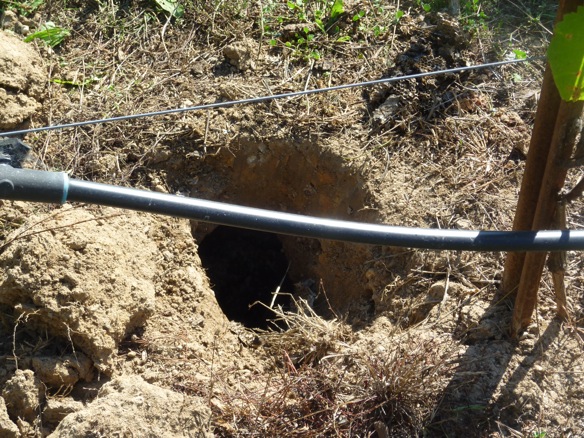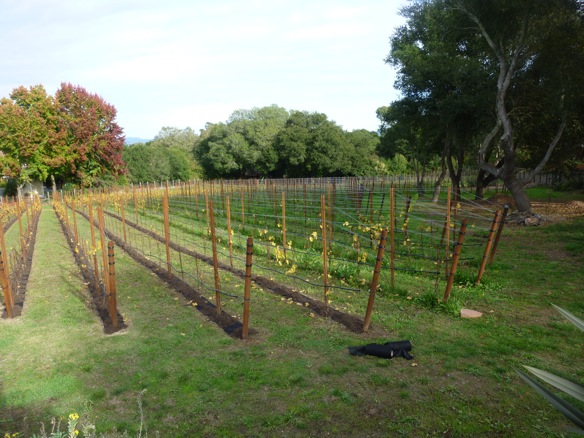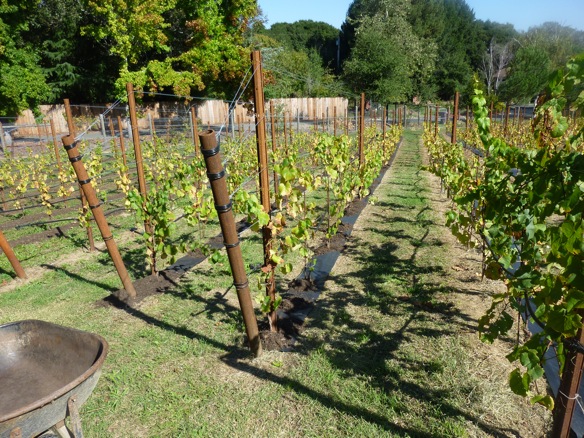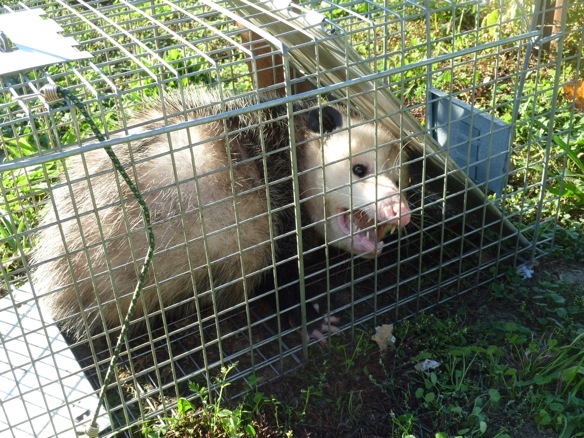 While we were laying out the weed cloth….we found a ground wasp nest. While I don’t like to get stung, they are considered to be beneficial around home gardesn to control caterpillars, spiders and flies. Too bad for these guys that I didn’t want them where they were, so I got rid of them with boiling water at dusk. Took two tries….but they have now either perished or moved. Last night I looked took dirt off the top and found out how big it was. It is hard to tell from the picture, but it is around 1 foot deep and 1 foot across. By the way……I uncovered the nest last night and it had a lot of the comb left….but by this morning some animal had gone into the nest and feed on the comb!
While we were laying out the weed cloth….we found a ground wasp nest. While I don’t like to get stung, they are considered to be beneficial around home gardesn to control caterpillars, spiders and flies. Too bad for these guys that I didn’t want them where they were, so I got rid of them with boiling water at dusk. Took two tries….but they have now either perished or moved. Last night I looked took dirt off the top and found out how big it was. It is hard to tell from the picture, but it is around 1 foot deep and 1 foot across. By the way……I uncovered the nest last night and it had a lot of the comb left….but by this morning some animal had gone into the nest and feed on the comb!
Monthly Archives: October 2011
New weed cloth method
 So…..we did the previous 16 rows by cutting the weed cloth inside in 20 foot sections. To much work! Now, we purchased the weed cloth and then cut it in 1 foot sections and rolled it out in the vineyard and cut it in place. The only issue is that when I cut it (since the cost from the vendor was double the price) the plastic material melts. So, I have to cut fast and only use smaller rolls so this does not happen.
So…..we did the previous 16 rows by cutting the weed cloth inside in 20 foot sections. To much work! Now, we purchased the weed cloth and then cut it in 1 foot sections and rolled it out in the vineyard and cut it in place. The only issue is that when I cut it (since the cost from the vendor was double the price) the plastic material melts. So, I have to cut fast and only use smaller rolls so this does not happen.
Work is now progressing on the vineyard weed project…..here is the work so far:
10/17 3 hours
10/18 5.5 hours
10/19 4 hours
10/20 4 hours
10/21 2 hours
10/24 2 hours
10/25 2 hours
10/26 2 hours
10/27 2 hours
10/29 2 hours
10/31 7 hours, hired hours – all for septic
Total 35.5 hours with and additional 7 hired.
Again……probably 150 hours to complete this project. I’ll probably hire some folks later in the year when I get the process set. (and I get tired of doing it!)
Weed cloth and mulch…..will see if it works by christmas
 So….last month I was trying several methods to get rid of weeds. Here is what I found out….raccoons like to look under cardboard…..some weeds grow through mulch…..mulch compresses and will hold up to mowing next to it…..cutting and laying weed cloth is a lot of work, but I hope will be worth it next year! The above picture is a before and after of applying the material and mulch. I think it looks fantastic and I’m hoping that it will look the same for many years to come.
So….last month I was trying several methods to get rid of weeds. Here is what I found out….raccoons like to look under cardboard…..some weeds grow through mulch…..mulch compresses and will hold up to mowing next to it…..cutting and laying weed cloth is a lot of work, but I hope will be worth it next year! The above picture is a before and after of applying the material and mulch. I think it looks fantastic and I’m hoping that it will look the same for many years to come.
Here is our process so far……cut the weed cloth into 1’ widths, cut to 20’ 4” (one section of the vineyard from highway stake to highway stake), cut 7” slits 40” apart so it will slide over the vines, slide them over the vines and adjust, put a little mulch on top to hold it down and then cover with mulch. My guess is for our 3150 vines that have 2 miles of vine rows it will take 300 hours and 100 yards of mulch at a cost of $3000….which does not include our labor. I think it is about a 1.5 year payback and the vines should grow better also! Will see how happy I am next year….
Opossom……..caught in our trap by mistake!
Over 70 million years ago dinosaurs roamed the Earth. While they are now extinct, one animal who shared the same land with the dinosaurs still exists today… the opossum..
Despite its appearance, the opossum is not related to the rat. In fact, the opossum is a marsupial, or “pouched” mammal, and is therefore related to other marsupials such as the kangaroo and the koala. Like kangaroos and koalas, infant opossums stay inside the mother’s pouch to nurse and develop. The opossum holds the distinction of being North Americas’s only marsupial.
Opossums are born after an 11-13 day gestation period. The pink, embryonic-looking infants are so small at birth that 20 could fit into a teaspoon. The infants continue to develop inside the pouch. As they grow and the pouch becomes full, the juveniles then ride on the mother’s back until they are old enough to go out on their own.
The opossum has an average lifespan of 1 to 2 years. This short lifespan is due in part to the presence of many predators including dogs, cats and people. Sometimes the opossum is able to escape death by “playing ‘possum” or feigning death, and in so doing the predator may lose interest in the apparently dead animal and not eat it
The name “opossum” is derived from an Algonquian Indian word “apasum”, meaning white animal. While there are over 65 species of opossums, only one, the Didelphis virginiana, more commonly known as the Virginia opossum, is native to North America. Didelphis means double womb and refers to the pouch as a secondary place of development for the infant opossums. Virginiana refers to the state of Virginia where the opossum was first observed by early English colonists. However, opossums today can be found throughout most of the United States and portions of Canada and Mexico.
The opossum has many interesting features. It has 50 teeth, more than any North American land mammal. Its hairless tail is prehensile and is used for grasping branches, balancing and carrying nesting material. The opossum does not hang upside down by the tail, a common misconception. The opossum also has opposable thumbs on its hind feet for holding onto branches.
Whether rural, residential or in the wilderness, opossums are a benefit to any area they inhabit. Their diet includes all types of bugs and insects including cockroaches, crickets and beetles. They love snails. They also eat mice and rats. The nocturnal opossum is attracted to our neighborhoods by the availability of water, pet food left out at night and overripe, rotting fruit that has fallen from trees. The opossum in turn helps keep our neighborhoods clean and free of unwanted, harmful garden pests and rodents, which may carry diseases. The opossum has earned the title of “Nature’s Little Sanitation Engineer.”
